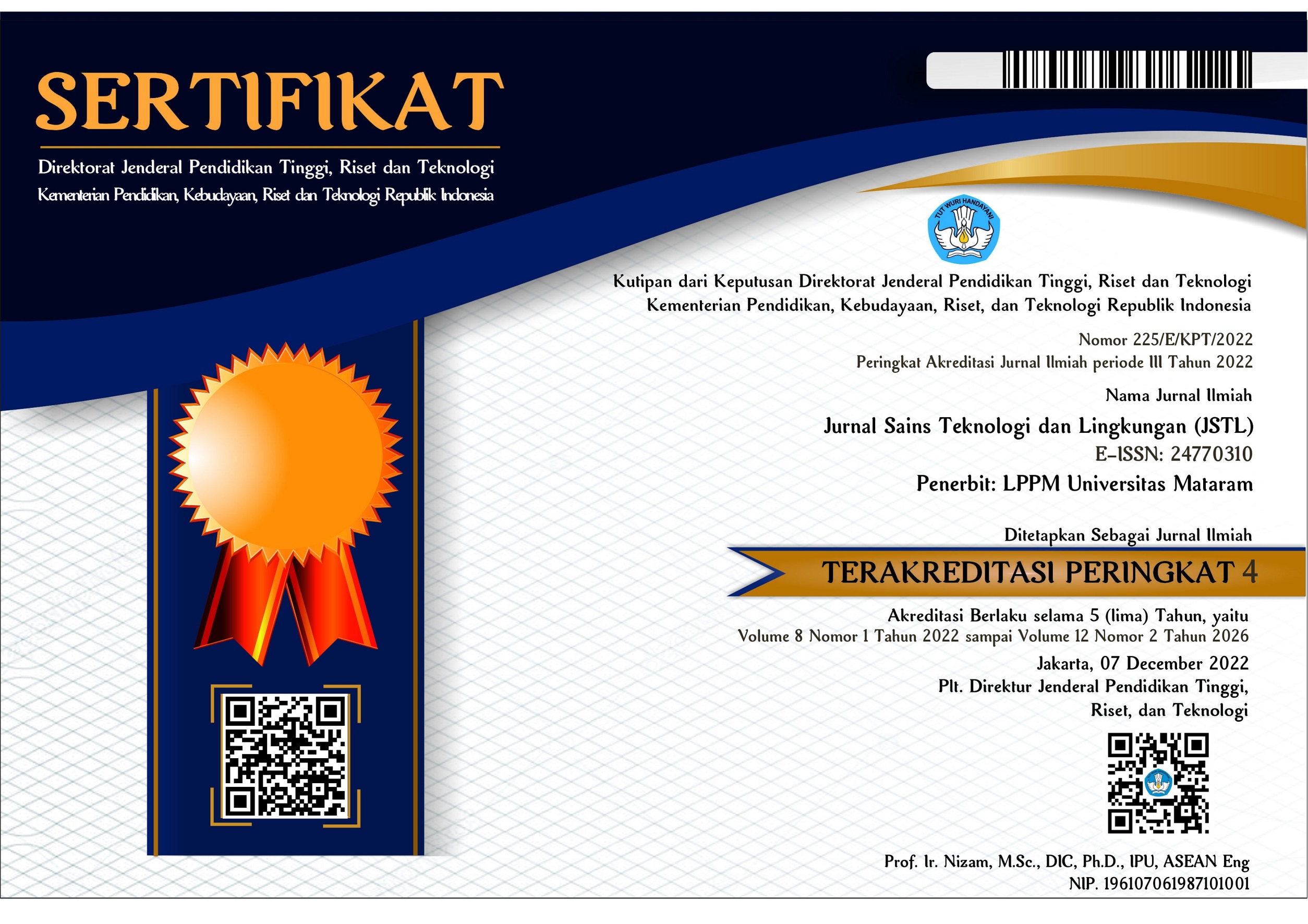Pengolahan Tanah Tercemar Logam Berat Pb dan Cd Menggunakan Biochar Sekam Padi dengan Variasi Ukuran Partikel
DOI:
https://doi.org/10.29303/jstl.v7i1.215Keywords:
Biochar, rice hus, heavy metals, particle sizeAbstract
Soil contamination by heavy metals lead (Pb) and cadmium (Cd) is a form of pollution that is very dangerous for living things. One of the efforts to cultivate polluted soil is the remediation method using biochar from rice husks. The purpose of this study was to analyze the effect of biochar particle size variations on the removal of heavy metals Pb and Cd on contaminated soil. Biochar is made by pyrolysis at 500 0C for 1 hour and flows 0.1 L / minute of N2 gas. This study used a variety of biochar particle sizes of 100 mesh, 60 mesh, 40 mesh and testing time every 10 days for 1 month. The results of this study were the highest Pb and Cd removal in the addition of biochar with a particle size of 100 mesh, namely with a Pb concentration of 91.32 mg / kg and a removal efficiency of 54.05% ; Cd concentration of 10.47 mg / kg and a removal efficiency of 47.36%. Based on the results obtained, it can be stated that the smaller the biochar particle size, the efficiency of heavy metal removal will increase.References
Abdelhafez, A.A, dkk. 2014. Feasibility of Biochar Manufactured Fromorganic Wastes on the Stabilization of Heavy Metals in a Metal Smelter Contaminated Soil. Chemosphere. Vol. 117. Hal. 66–71.
Adelia. 2004. Evaluasi Kadar Ambien Logam Berat Nikel (Ni) Dan Timbal (Pb) Dalam Tanah Sebagai Dasar Penyempurnaan Kriteria Baku Mutu Tanah Di Indonesia. Skripsi. Institut Pertanian Bogor.
Affan, M.F. 2014. Analisis Perubahan Penggunaan Lahan Untuk Permukiman Dan Industri Dengan Menggunakan Sistem Informasi Geografis (SIG). Jurnal Ilmiah Pendidikan Geografi. Vol. 2 No.1. Hal. 49-60.
Ahiduzzaman, M dan Islam, A. K. M. S. 2016. Preparation pf Porous Bio-char and Activated Carbon from Rice Husk by Leaching Ash and Chemical Activation. SpringerPlus. Vol. 5. Hal. 1248
Alaboudi, K, dkk. 2019. Effect of biochar on Pb, Cd and Cr availability and maize growth in artificial contaminated soil. Annals of Agricultural Sciences. Hal. 95–102
Azizi, A. A, dkk. 2019. Pengaruh Massa Bio-Char Kayu Akasia (Acacia Mangium) dan Waktu Perendaman Bio-Char terhadap Adsorpi Sebum Buatan. Jurnal Riset Sains dan Kimia Terapan. Vol. 08.
David H, dkk. 2013. Beneficial Effects of Biochar Application to Contaminated Soils on the Bioavailability of Cd, Pb and Zn and the Biomass Production of Rapeseed (Brassica napus L). Biomass and Bio Energy. Vol. 57. Hal. 196-204.
Fahmi, A. H. dkk. 2018. Bioavailability and Leaching of Cd and Pb From Contaminated Soil Amended with Different Sizes of Biochar. Environmental Science.
Handiyatmo.E.T. 1999. Adsorpsi Polutan Komponen Ganda Senyawa Fenol (2,4 DCP dan Fenol) Dengan Zeolit. Yogyakarta: Universitas Gadjah Mada,
Hardjowigeno, S. 2007. Ilmu Tanah. Jakarta: Pustaka Jaya.
Juhaeti, T, dkk. 2004. Inventarisasi Tumbuhan Potensial Untuk Fitoremediasi. Jurnal Biodiversitas. Vol. 6 No. 1 hal 31-33.
Komarek M, dkk. 2013. Chemical stabilization of metals and arsenic in contaminated soils using oxides a review. Environ Pollut. Vol. 172. Hal. 9–22
Krishnarao R. V, dkk. 2000. Studies on the formation of black in rice husk silica ash. J. Ceramic Society. Vol. 21. Hal. 99 – 104.
Li, Q, dkk. 2010. Fast Esterifikasi of Spent Grain for Enhanced Heavy Metal Ions Adsorption. Bioresource Technology. Vol. 101. Hal. 3796-3799
Li, H. 2017. Mechanisms of metal sorption by biochars: Biochar characteristics and modifications. Chemosphere. Vol. 178. Hal. 466–478.
Lu, H, dkk. 2012. Relative distribution of Pb2+ sorption mechanisms by sludge derived biochar. Water Research. Vol.46. Hal. 854–862.
Ministry Of State for Population and Environment republic of Indonesia and Dalhousie University Canada, 1992. Environmental Management in Indonesia. Report on Soil Quality Standards for Indonesia (interim report).
Nurida, N.L. 2014. Potensi Biochar untuk Rehabilitas Lahan Kering di Indonesia. Jurnal Sumberdaya Lahan Edisi Khusus. Hal 57-68.
Pavia, D.L, 2009. Introduction to Spectroscopy Fourth Edition, Brooks/Cole Cengage Learning, USA
Penido, E. S, dkk. 2019. Combining biochar and sewage sludge for immobilization of heavu metals in mining soils. Ecotoxicology and Environment Safety. Vol. 172. Hal. 326-333.
Prabawati, S, dkk. 2008. Teknologi Pascapanen dan Pengolahan Buah Pisang. Balai Besar Penelitian dan Pengembangan Pascapanen Pertanian. Dalam seminar Badan Litbang Pertanian. Departemen Pertanian, Bogor.
Putri, V. I, dkk. 2017. Pemberian Beberapa Jenis Biochar Untuk Memperbaiki Sifat Kimia Tanah Ultisol dan Pertumbuhan Tanaman Jagung. Jurnal Agroekoteknologi. Vol. 5. No. 4. Hal. 824-828.
Sastrohamidjojo, H. 2014. Kimia Organik dasar. Yogyakarta: UGM
Shi, J, dkk. 2019. Removal of lead by rice husk biochars produced at different temperatures and implications for their environmental utilizations. Chemosphere. Hal. 825-831.
Syuhadah, N dan Rohasliney, H. 2012. Rice Husk as Biosorbent: a review. Health and Environmental Journal. Vol. 3 No. 1. Hal. 15-24.
Tan, X, dkk. 2015. Application of Biochar for the Removal of Pollutants from Aqueous Solutions. Chemosphere. Vol. 125, Hal. 70–85.
Uchimiya, M, dkk. 2011. Screening Biochars for Heavy Metal Retention in Soil. role of oxygen functional groups. J. Hazard Mater. Vol. 190. Hal. 432-441.
Xu X, Y. 2015. The Sorption and Transformation of Inorganic Contaminants by Biochars and the Underlying Mechanisms. China: Shanghai Jiao Tong University.



1.png)











